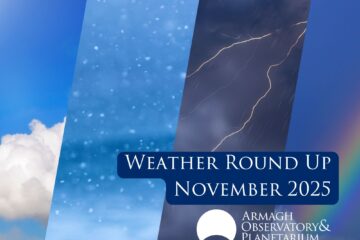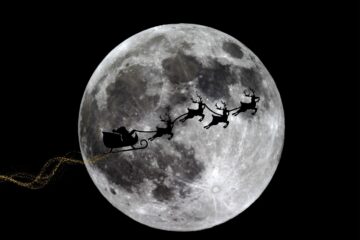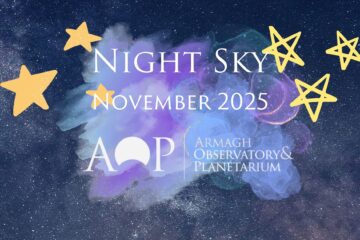So the nights are drawing in and in as we get closer to the festive season, and though Christmas might not be quite the same as usual this year, there’s still plenty to celebrate. One great socially distanced activity you can do is stargazing! It’s outdoors and doesn’t require a group, and so you can easily go out and have a wee look up at the stars – just make sure to wrap up warm at this time of year!

The winter sky this December is a gorgeous display of some fascinating stars and deep-sky objects which you can see with the naked eye, and we even have two meteor showers to keep your eyes occupied during even more lockdowns.

The standout constellation of the winter months is Orion. It contains loads of bright stars, and if you have a telescope you might even be able to see the Orion Nebula in full detail. You don’t need a telescope just to spot the Orion Nebula, though, as its one of the brightest Nebulae, and can be seen below Orion’s famous belt. The belt is part of the reason why Orion is so easy to spot in the night sky, but it also contains a two bright stars that can tell you a little bit about the life cycle of stars. The first is the main star of Orion – Rigel.

Rigel is a young, hot star about 860 light years away from our solar system and it shines a lovely bright blue-white colour in the night sky. Rigel, designated a blue supergiant, shows us the first stage in the life cycle of stars: when they are young they are hot and blue. On the other hand there is Betelgeuse, in the shoulder of Orion, which represents the end stages of the star’s life cycle.

Betelgeuse is large, but cool, and it shines an orange red colour – so we call it a red Supergiant. When stars get older they cool down and start emitting red light. In this way, you can tell the approximate life stage of a star by its colour. Betelgeuse is a great example of an old star – it has been behaving a bit oddly recently, and astronomers believe it might soon reach the final stage of its life. This is the exciting stage – it might soon go Supernova. This means that it will explode and then collapse – possibly ending up as a neutron star. This is a star about the mass of the sun, but squeezed into a space only a few kilometers in diameter. This thype of star has a massive gravity – pulling matter towards it. However, even if this did happen, we would not need to worry – at nearly 650 light years away from us the new neutron star will not be close enough to us to do any harm. In fact, the supernova that creates the neutron star will be quite beautiful from earth. It will light up until it is almost as bright as a full moon, and will be visible even during the day for a few months. It is hard to predict when this will happen exactly – it could be anytime in the next 100,000 years – a blink of an eye for a star, but quite along time for us lowly humans.
The unusual thing about Betelgeuse, is that it is actually younger than our sun. It is just much larger, and the larger a star, the shorter its lifespan.
The, first meteor shower you can see this month is called the Geminids. The Geminids are known as the king of meteor showers – and take place in mid-December every year. You can see up to 120 meteors per hour on a clear night at this shower’s peak, although it hasn’t always been that way! The Geminids first appeared in 1862, and they were a rather weak shower at the time, with 10-20 meteors an hour. Then, it was assumed that meteor showers were an atmospheric phenomenon, as opposed to an astronomical one. It makes a little bit of sense, this theory, as no meteorites have ever been found on earth due to a meteor shower. However, we know better nowadays, and once the truth came to light, work soon started on discovering the source of the Geminids meteor shower.
All meteor showers that we know of are caused by the Earth’s orbit passing through the debris trailed behind a comet. The Perseids – a prolific meteor shower that takes place every summer – are caused by the comet Swift-Tuttle as it travels around the sun, leaving a trail of rocks and dust in its wake, left travelling in the shape of the comet’s 133 year orbit. The Geminids, then, were a startling exception, as no suitable comet had been found that could be its progenitor. In fact, any comet that could cause such a shower would have to be a quite unusual one, with a very short period orbit.

At last, in 1983, a suitable body was found that could explain the short orbital period of the Geminids – it was, controversially, not a comet, but an asteroid. 3200 Phaethon, the asteroid in question, is a 5.8km rock which orbits the sun once every 524 days (which explains the Geminids short orbit), in a slightly (compared to the average comet) elliptical orbit that stretches as far as the Asteroid belt, at its farthest from the sun. So the Geminids are an unusual meteor shower – the only known shower to be caused by anything other than a comet! Look out for the Geminids from the 13-15 of this month – the new moon coincides with the shower so viewing conditions should be ideal! The meteors will appear to come from the direction of the constellation Gemini (hence their name), but may be seen anywhere in the sky from 7-17 Dec.

The other meteor shower we can see in our skies this month is a more minor one – although it is named for a very famous constellation, Ursa Minor, which contains the pole star. Meteor showers are designated as major or minor based on the number of meteors seen per hours at its peak. The Ursids is a minor shower because around 5-10 meteors can be seen per hour at its peak on the 21 and 22nd Dec 2020. Again, viewing conditions should be good, as although there is a half moon in the sky, it will set early in the night to allow the meteor shower to take centre stage. Because it is a minor shower, and because of its timing, the Ursids don’t get much of a look in on the astronomical calendar. But Christmas is going to be a little different this year – so why not start a new socially distanced tradition and have a look out (especially in rural areas) for that little meteor shower this year.

As mentioned, the New Moon will be in the Sky on the 14th of December this year, and the Full moon will be on the 30th, right at the end of the month. This full moon has been named the ‘Cold Moon’ by early Native Americans, for obvious reasons, but has also been called the Long Nights moon or the moon before Yule (even though it’s after yule this year).

You can see a number of planets in the sky this month. Standing out are Mars, the red planet, which appears this month in Pisces. Mars is a distinctive red colour (as you might imagine) in the sky, making it more easily distinguishable from the other planets. You can tell planets in general apart from stars by looking at them for a longer time – do they twinkle like stars? If not they are a planet.
Not only can you see both Jupiter and Saturn in the night sky this month, you will even be able to see them ‘kiss’! Happening this month is ‘The great conjunction’ – this will be the closest visible conjunction of Saturn and Jupiter seen since 1623! The planets will appear to us as if they were touching in the night sky which only happens every 19 years – so you’ll have to wait until 2040 to see them in conjunction again. What makes this particular event so special is that the planets are coming closer than ever: to within 0.06 degrees of each other! You’ll be able to see them clearly in the south western twilight sky as they shine bright close to the horizon.
So quite a few spectacles to look out for this month if you’re stuck for something to do while isolating. Even if you’re not though, there are chances to see events that happen only very rarely, so get out the binoculars (if you fancy) and wrap up warm to head outside take a look. Your Christmas celebrations will look different this year, but you can always look to the skies for constant beauty! Merry Christmas!




0 Comments